Choosing the correct water filter for your specific needs can be challenging. Not only are there multiple filter designs to choose from, but there are also numerous types of filter media which each offer their own unique performance characteristics.
In this guide, I’ll be sharing the 12 most popular media that you are likely to come across in water filters today.
Table of Contents
❔ What is Water Filtration Media?
Filtration media can be a fine powder, a coarse mineral, a granular substance, or a substrate, that resides within a filter cartridge, media tank, or housing, which filters water as it flows through the system. Depending upon its makeup, a filtration media may remove particles of specific sizes or forms.
When water flows through filter media at a controlled rate, the media retains the impurities that it is designed to remove. Most solid matter can be captured, while treated water is allowed to pass through.
🆚 What’s the Difference Between Filter Media and a Filtration System?
Filter media is the material contained within a filtration system.
A filtration system refers to the type of unit which contains, houses and manipulates the media or substrate (flow-through housings, automatic backwashing systems, reverse osmosis units, countertop or under-sink models, etc.).
The media itself and the unit design will dictate the exact processes that take place inside the system.
When purchasing a filtration system, it is important to examine the system and the filtration media it contains. Some media are better at removing certain impurities than others, and some media are simply a better quality media overall.
📋 Common Types of Water Filter Media
If you buy a water treatment system in the US, it’s highly likely that it will contain one or more of the following media:
Activated Carbon
Activated carbon is the most popular and widely-used filter media today. It is produced from organic material that has a naturally high carbon content, such as coconut shell, charcoal, or wood.
This material is heated under controlled conditions, but not burned, producing a char-like product. This char can then be activated or converted into a porous material that can capture certain impurities and contaminants in a process known as adsorption.
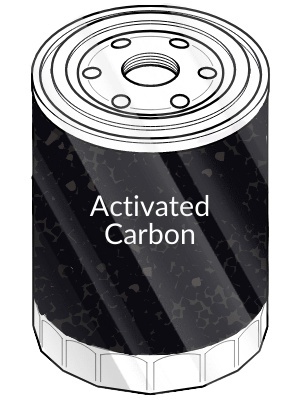
The quality of an activated carbon is dependent upon several factors, primarily its base material and secondarily the process by which it is produced.
Wood is the least popular option for this filtration media, while charcoal or coal is relatively popular.
One commonly used material is coconut shell, which has the advantage of being less environmentally impactful to produce, and results in a reasonably high quality end product.
You can find activated carbon water filtration media in a broad range of filtration systems, including water pitcher filters, water bottle filters, reverse osmosis systems, under-sink water treatment units, and whole-home filtration systems.
Activated carbon media is best-known for its ability to remove chlorine (taste and odor), as well as lead and certain pesticides. It can also remove several other organic impurities, copper, and chlorination byproducts such as trihalomethanes.
Catalytic Carbon
Catalytic carbon and activated carbon might have similar names, but they’re unique in their contaminant removal capabilities. Catalytic carbon is a type of highly activated granulated carbon that has been surface modified to have an improved ability to promote chemical reactions.
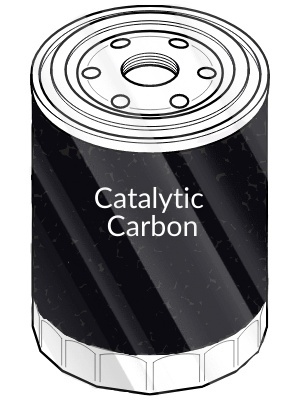
One of the primary roles of catalytic carbon is to filter out chloramine, a chemical compound made from chlorine and ammonia.
Chloramine is used in some regions as a chlorine enhancement to disinfect water. Chloramine resists dissipation better than chlorine alone, which allows it to remain in a system as a residual disinfectant for a greater duration.
The extended disinfectant benefits of chloramine are part of what makes it more difficult to remove from water with a standard activated carbon filter.
Catalytic carbon filters are designed to remove the majority of chloramine from water, while activated carbon media can only get rid of a small percentage of this chemical.
Activated Aluminum
Activated aluminum is typically found in ion exchange water treatment systems. This media is capable of removing calcium and magnesium minerals, which are largely responsible for water hardness (and, therefore, limescale).
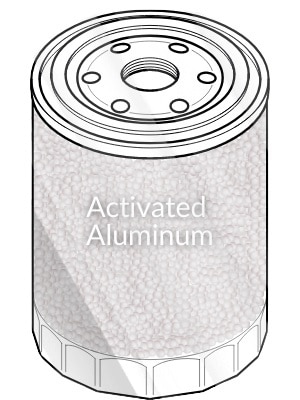
If water is allowed a long enough contact time with activated alumina media, it can also reduce arsenic and fluoride.
The type of activated aluminum used can also affect which impurities are removed. Some types of this media can filter out barium and radium.
You might also hear activated aluminum media referred to as a resin.
KDF (Kinetic Degradation Fluxion)
KDF, or kinetic degradation fluxion media, is made from a combination of zinc and copper particles. Depending on the type of KDF media you opt for, you can use this filter material to remove everything from iron and hydrogen sulfide to chlorine and bacteria. Some types of KDF are suitable for managing scale and algae.
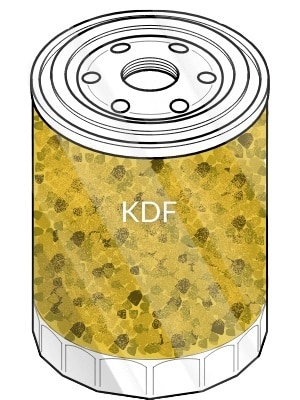
While KDF media is another highly effective chlorine removal option, it isn’t quite as effective as activated carbon or granulated activated carbon media. However, it tends to be cheaper to maintain and lasts longer than carbon. It can also be used to filter water at higher temperatures, which could give it the advantage over carbon for some uses.
If you’re dealing with a particularly difficult chlorine problem, you could use a KDF media upstream of a carbon filter. The KDF filter would help to extend your carbon filter’s lifespan, and the carbon filter would be able to trap contaminant particles that had managed to pass through the KDF media.
Reverse Osmosis Membranes
Reverse osmosis membranes are the most important feature of a reverse osmosis water filtration system.
RO can reduce up to 99% of TDS from water, making it a popular choice for those looking to produce pure, clean, contaminant-free drinking water.
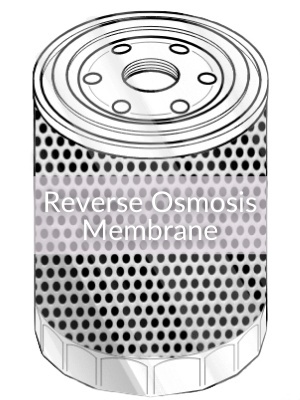
Reverse osmosis membranes, otherwise known as semipermeable membranes, have a pore size range of 0.001 to 0.0001. When water is forced through this thin film composite or cellulose acetate substrate, particles that are larger than this pore size cannot permeate the membrane pores.
Essentially, only water particles are small enough to pass through. The concentrate is rejected to drain.
As well as the easy-to-remove contaminants (such as chlorine, heavy metals and arsenic), a reverse osmosis membrane can also reduce dangerous and difficult-to-remove contaminants, like asbestos, chromium-6, and fluoride.
While most filter materials are incapable of eliminating microorganisms like bacteria, reverse osmosis membranes have pores that are small enough to block bacteria from passing through. They can also reliably filter metallic ions and salt from water.
Reverse osmosis membranes don’t trap their impurities within the substrate. Instead, contaminants are expelled down the drain during the RO filtration process.
Ultraviolet Light (UV)
Ultraviolet light is a highly effective technique for destroying bacteria, viruses and other microorganisms that may exist in a water supply.
A UV light is housed inside a UV chamber. When water passes into this chamber, the UV rays produced by the lamp damage the DNA of any existing microbes, killing them and making them unable to reproduce. As a result, microorganisms like giardia and E.Coli are no longer a threat to health if consumed in the water.
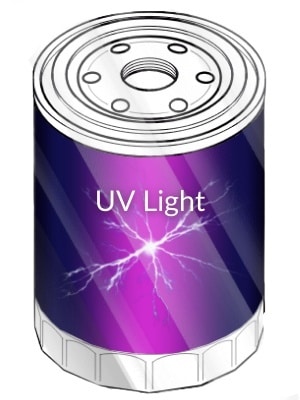
UV disinfection is most commonly used as a standalone water treatment option that can be included with whole-house or under-sink water filtration systems.
The biggest advantage of ultraviolet water disinfection is that, unlike chlorine or chloramine disinfection, UV doesn’t add harsh chemicals to the water during treatment.
However, the biggest disadvantage is that there is no residual disinfection agent.
Manganese Dioxide
Manganese dioxide is a type of filtration media that can be used to reduce iron, manganese, and hydrogen sulfide – three impurities that are commonly found in private wells.
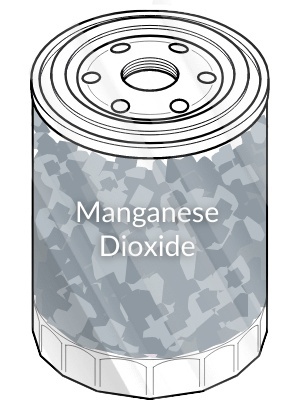
Iron is one of the minerals our bodies need to survive, but in water, it can cause aesthetic issues, including rusting and staining. Iron can also affect the taste of your water, making it unpleasant for drinking, cooking and making tea or coffee. Iron can even leave reddish-brown deposits on your laundry and tableware.
Manganese dioxide shouldn’t be confused with manganese greensand, mentioned later in this article.
Calcite
Calcite is made from white calcium carbonate that has been crushed and screened. This material is most commonly used to increase water’s pH or alkalinity, preventing corrosion and aesthetic damage from acid.
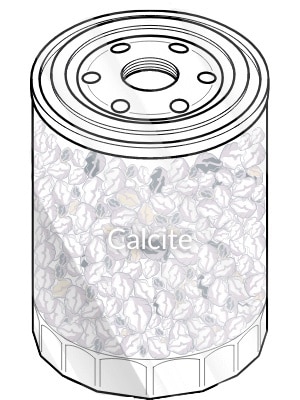
Calcium carbonate is dissolved into the water, which does two things: increases its pH and increases its hardness. For this reason, it’s recommended that you use a water softener alongside a calcite water filter, as hard water can damage your plumbing just as much as acidic water.
As well as boosting water’s pH, calcite can also be used to remove ferric hydroxide iron, otherwise known as cloudy iron.
Calcite doesn’t need to be regenerated, but rinsing and backwashing may be required depending upon the application.
Filter Ag
As a granular, lightweight filter material, filter Ag (short for filter aggregate) is a fairly common filter media that is primarily used for the removal of turbidity in well water.
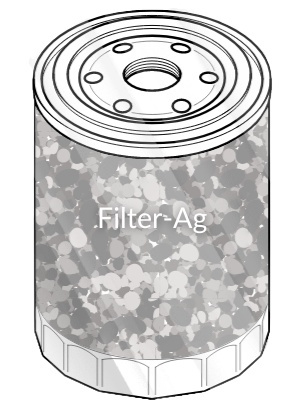
A filter Ag filter can typically remove particles around 20 microns in size. Again, this filter material needs to be backwashed regularly to wash away the buildup of sediment.
Birm
A type of granular filter that is commonly used for removing iron, manganese, and some hydrogen sulfide, birm is a popular whole-house filtration media for well applications. For birm to effectively filter water, it must have a neutral pH.
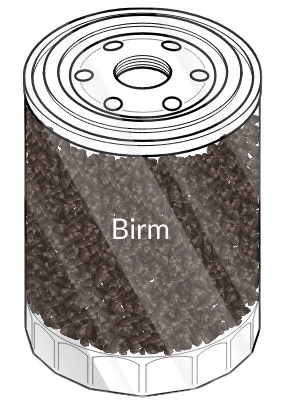
Birm acts as an insoluble catalyst, enabling dissolved oxygen and manganese/iron to undergo oxidation. The contaminants then become trapped in the birm. When the media becomes saturated with manganese and iron, backwashing and rinsing will be required.
Manganese Greensand
Manganese greensand is very similar to birm in its contaminant removal capabilities. This material is commonly used within an air-injection/oxidation system or with a potassium permanganate regenerant for the removal of iron, manganese and hydrogen sulfide.
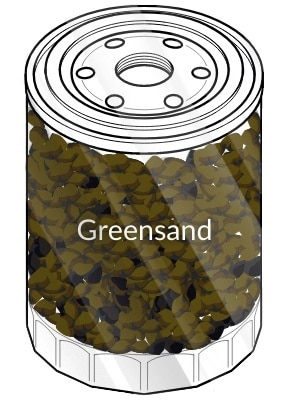
In this system, water flows through a bubble of oxygen, which oxidizes contaminants like iron and manganese, causing them to precipitate out of water. They become trapped in the manganese greensand in the tank, which holds onto the contaminants and prevents them from being able to leave the system with the water.
Eventually, the manganese greensand will become so saturated with hydrogen sulfide, iron and manganese that it will need to be backwashed and rinsed. Most systems will flush themselves automatically, replenishing the oxygen bubble as well as the media bed.
Mixed Media
It’s becoming more and more common for systems to combine several materials in one, known as mixed-bed or multi-media filters.
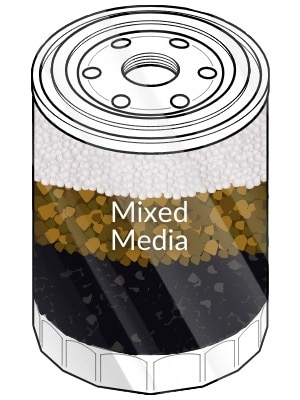
The advantage of multi-media filters is that they can remove a greater variety of drinking water contaminants than any single media could remove alone. A multi-media filter may be able to remove sediment and heavy metals, or chloramines and water hardness, all within one water filter.
Multi-media filters may utilize a wide variety of different media. including gravel, sand, anthracite, garnet, carbon, catalytic carbon, among other media.

I feel that we can get clean drinking water for every home by making good use of reverse osmosis membranes. Thanks, Michael Claybourn Sr.